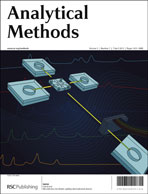An alternative method for screening of Sudan dyes in red paprika paste by gas chromatography-mass spectrometry
Abstract
An indirect analytical screening method for Sudan dyes by gas chromatography mass spectrometry was developed as an alternative method to novel liquid chromatography mass spectrometry. Red paprika paste samples were extracted with acetone and centrifuged at room temperature. The supernatant was removed from the solution and buffered. The reduction step is performed chemically with sodium dithionite and corresponding dyes as amine products were identified by GC-MS. The method was validated for analytical properties using spiked paste samples. Several parameters which may influence the reduction procedure, such as temperature and the amount of reducing agent, were optimized using central composite design methodologies for Sudan III in order to increase its lower apparent recovery as compared with the others. Optimum conditions for Sudan III were found to be 45 °C and 1.3 M by using a central composite design. The apparent recovery values were 77.6%, 69.4%, 51.3%, 42.5% with relative standard deviations of 31.8%, 20.4%, 20.3%, 31.2% for Sudan I, II, III, IV dyes respectively. This method was used successfully for screening of Sudan dyes in paprika paste products by GC-MS.


 Please wait while we load your content...
Please wait while we load your content...